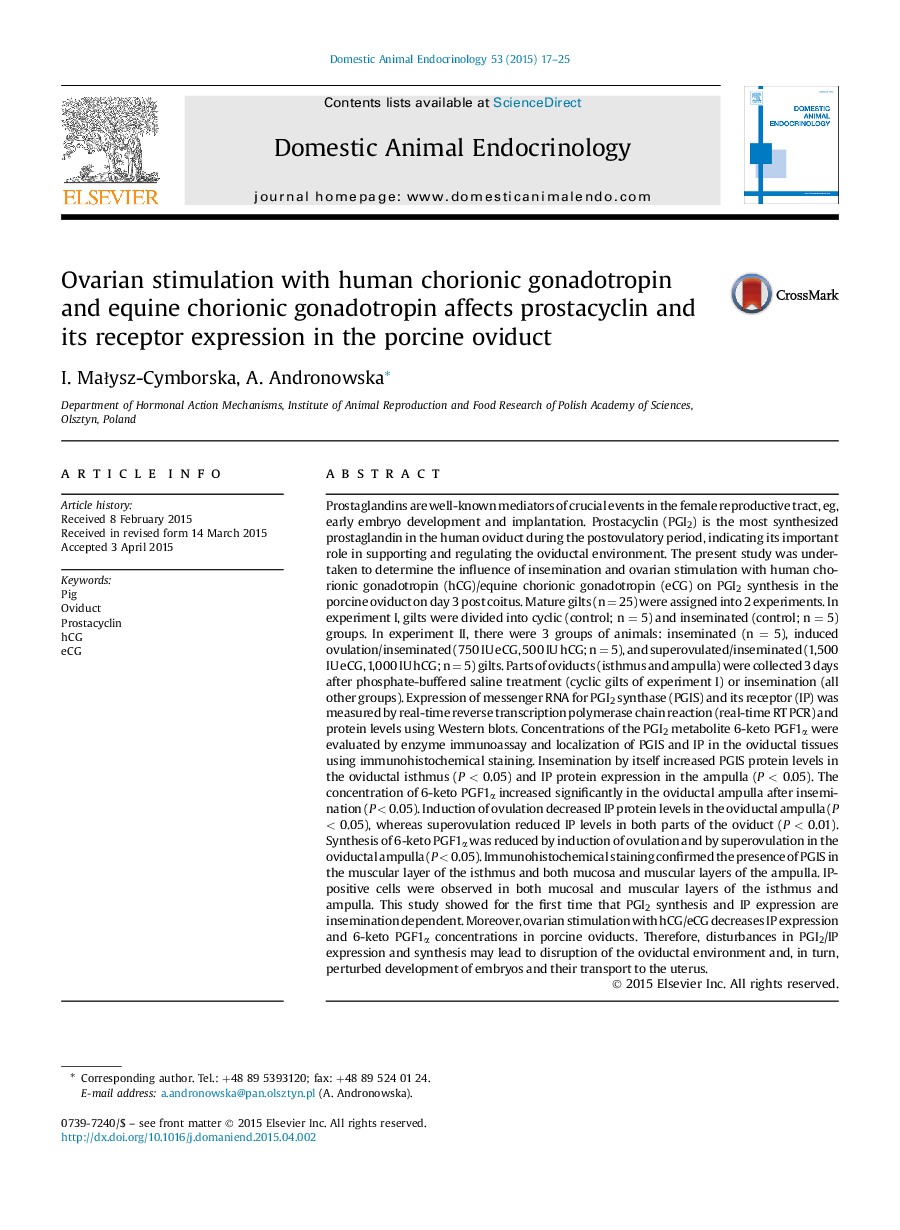| کد مقاله | کد نشریه | سال انتشار | مقاله انگلیسی | نسخه تمام متن |
|---|---|---|---|---|
| 2393440 | 1551506 | 2015 | 9 صفحه PDF | دانلود رایگان |
• Insemination increases prostacyclin synthesis and its receptor expression in porcine oviducts.
• Increase of prostacyclin/its receptor in oviducts after insemination imply role in embryo growing.
• Gonadotropins affect prostacyclin and its receptor expression in porcine oviducts on day 3 p.c.
• Changed prostacyclin/receptor synthesis may disturb oviductal milieu and embryo development.
Prostaglandins are well-known mediators of crucial events in the female reproductive tract, eg, early embryo development and implantation. Prostacyclin (PGI2) is the most synthesized prostaglandin in the human oviduct during the postovulatory period, indicating its important role in supporting and regulating the oviductal environment. The present study was undertaken to determine the influence of insemination and ovarian stimulation with human chorionic gonadotropin (hCG)/equine chorionic gonadotropin (eCG) on PGI2 synthesis in the porcine oviduct on day 3 post coitus. Mature gilts (n = 25) were assigned into 2 experiments. In experiment I, gilts were divided into cyclic (control; n = 5) and inseminated (control; n = 5) groups. In experiment II, there were 3 groups of animals: inseminated (n = 5), induced ovulation/inseminated (750 IU eCG, 500 IU hCG; n = 5), and superovulated/inseminated (1,500 IU eCG, 1,000 IU hCG; n = 5) gilts. Parts of oviducts (isthmus and ampulla) were collected 3 days after phosphate-buffered saline treatment (cyclic gilts of experiment I) or insemination (all other groups). Expression of messenger RNA for PGI2 synthase (PGIS) and its receptor (IP) was measured by real-time reverse transcription polymerase chain reaction (real-time RT PCR) and protein levels using Western blots. Concentrations of the PGI2 metabolite 6-keto PGF1α were evaluated by enzyme immunoassay and localization of PGIS and IP in the oviductal tissues using immunohistochemical staining. Insemination by itself increased PGIS protein levels in the oviductal isthmus (P < 0.05) and IP protein expression in the ampulla (P < 0.05). The concentration of 6-keto PGF1α increased significantly in the oviductal ampulla after insemination (P < 0.05). Induction of ovulation decreased IP protein levels in the oviductal ampulla (P < 0.05), whereas superovulation reduced IP levels in both parts of the oviduct (P < 0.01). Synthesis of 6-keto PGF1α was reduced by induction of ovulation and by superovulation in the oviductal ampulla (P < 0.05). Immunohistochemical staining confirmed the presence of PGIS in the muscular layer of the isthmus and both mucosa and muscular layers of the ampulla. IP-positive cells were observed in both mucosal and muscular layers of the isthmus and ampulla. This study showed for the first time that PGI2 synthesis and IP expression are insemination dependent. Moreover, ovarian stimulation with hCG/eCG decreases IP expression and 6-keto PGF1α concentrations in porcine oviducts. Therefore, disturbances in PGI2/IP expression and synthesis may lead to disruption of the oviductal environment and, in turn, perturbed development of embryos and their transport to the uterus.
Journal: Domestic Animal Endocrinology - Volume 53, October 2015, Pages 17–25
